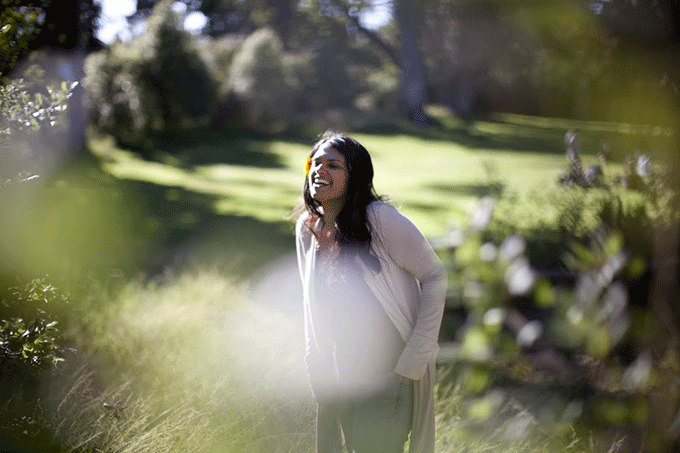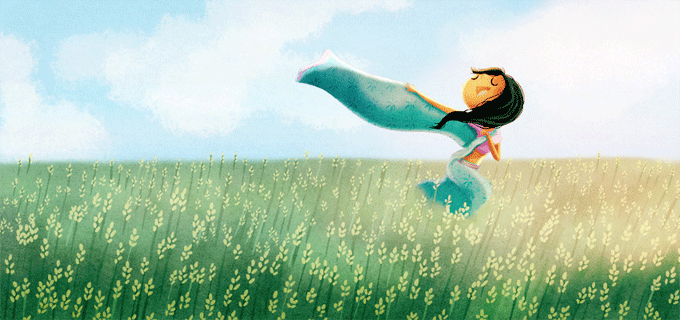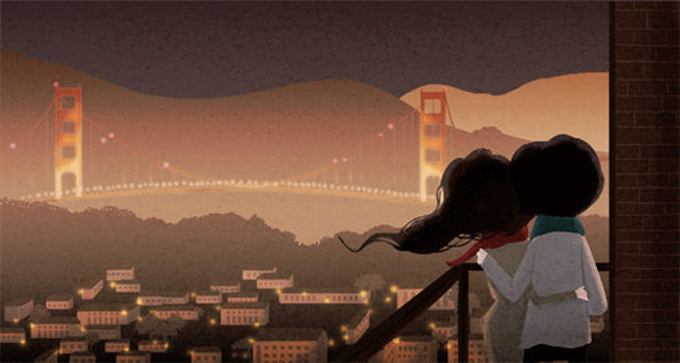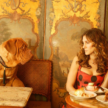Nidhi Chanani says she wants to make people smile. That’s why, three-and-a-half years ago, the Calcutta-born artist committed to churning out a drawing every single day and posting it to her website, Everyday Love. “I wanted to share those little moments in life that make people happy, that put a smile on their face.”
No one would dispute that her lively, colorful images are smile inducing. Sometimes romantic, often whimsical and always cheerful, they depict handsome young couples in love, strolling over bridges, snuggling in bed or wandering through moonlit city streets. They show mothers and daughters baking together or braiding one another’s hair; women alone, daydreaming over a cup of tea, playing acoustic guitar or riding a bicycle across a gorgeous landscape; and cuddly zoo animals frolicking against natural backdrops. Much of Chanani’s art is a love letter to her City by the Bay, with cable cars, the Golden Gate Bridge and other landmarks featured prominently. But she also pays homage to her Indian heritage and dabbles in other romance-inspiring metropolises, including New York.
Chanani, who was raised in Southern California, earned a degree in literature from U.C. Santa Cruz and attended the Academy of Art in San Francisco for a year-and-a-half before committing to her daily sketches. Since then, her fan base has grown steadily. In April 2012 she was honored at the White House as a Champion of Change. She’s made appearances on CNN-Anderson Cooper and BBC Radio and worked with companies like Hasbro, Paramount Pictures and Disney. Her most recent ventures are a greeting card line for the Papyrus chain and an upcoming graphic novel, Pashmina, to be released by First Second Books in 2016.
With all this going on, Chanani takes the time to talk to Red Typewriter about the challenges of creating a graphic novel, her desire to cultivate change within her community, and the way her hubby helps her keep it real.
Red Typewriter: Your images seem to be heavily inspired by your personal life. We’re wondering if, when you’re experiencing an art-worthy moment, you say to yourself, “Damn, this would make a great print.”
Nidhi Chanani: In the moment I’m usually not thinking about drawing, unless it’s an especially beautiful place or event. When I’m surrounded by a lot of natural beauty—like recently we were in Sonoma for a wine-country wedding—I try to take it all in, knowing that I can recall it later. I have a really visual memory and can mentally catalog things. It’s not all from memory, though. If I need to draw a landmark or a very specific location, I’ll look at photos to jog my memory. However, I try not to linger too long on a photo because then I find I want to draw everything in the photo. I would say the majority of my images come from actual memories or conversations or something that’s been in my mind for a while, so they have very different meanings to me than to another person. But that’s not a concrete rule. Recently I drew a bunch of jackrabbits just because they jump high and they’re fun to draw.
RT: When did it click for you that you could make a living as an artist?
NC: As a kid, I was always drawing. I came from this super traditional Indian family where everyone became a doctor or engineer, so I really wasn’t exposed to the idea that you could make money creating pictures and animation—I didn’t know a single person doing anything like that. It wasn’t until a little bit out of college that I became obsessed with the work of [Portland artist] Kurt Halsey, and the idea that painting every day could be someone’s job was revolutionary to me. So I started pursuing Saturday and evening classes, and [eventually enrolled] in art school and got a good foundation in color, light and shadow. Dropping out was a tough decision, but I felt that drawing every single day was the best way for me to become better at what I do. Since then I’ve accumulated more than 700 illustrations.
RT: You’re working on your first graphic novel, Pashmina, a story about first-generation immigrants who find their place in America. How does the process compare to everything else you’ve done?
NC: I’m finding it quite amazing to learn how to communicate in sequential art. While you can look at my stand-alone illustrations [without any context], with a graphic novel you need to know what comes before and what comes after each visual. You need to know when to rely on the text to communicate the story, and when to rely on the pictures—and when they must work together. The panel layout is complex; the illustrations need to move the story along and avoid become stagnant or redundant. Before starting on Pashmina, I had a lot of appreciation for graphic novels and novelists. But now that I have the firsthand experience, I realize just how incredibly challenging the process is. Sometimes I find myself face to face with my own limitations, drawing myself into a corner that spirals me down into thinking, “I suck, I can’t do this.” But most of the time it’s a wonderful challenge where I’m wondering, “How far can I push myself to make this more readable and more compelling?”
RT: What did it mean to be designated a White House Champion of Change?
NC: It was such an amazing honor to be at the White House with my family and friends and be able to speak there. It was also an experience I can look back on to avoid getting down on myself—because, like any artist, I can be hardest on myself. As an Indian woman in a field that’s dominated by non-Indian women, I’m pleased that the White House took the initiative to highlight somebody like me. There are a lot of unrealized passions in the Indian community, so it’s a step toward changing the landscape for future generations. Since then I’ve been invited to talk at many colleges to kids who are considering [creative careers]. I’m hoping that more parents in our community will encourage their kids to attend art school or creative writing school, or to pursue music. I hope that 10, 20 years from now this industry will look a lot more diverse.
RT: On your website you credit your husband, Nick, for being supportive of you professionally. Describe your relationship.
NC: Nick is kind of my right arm. He’s the person I go to first when making any business decision. He’s there when I need tech support, and he travels with me to shows. Right now he’s seeing the pages of my book before anyone else on the planet sees them. He’s my sounding board, my everything. He also grounds me and is my reality check. He’s the person who tells me at 9 o’clock at night when I’m still working, “Uh, maybe we should spend some time together.” When you go down a path that is very uncommon, your [significant other] must completely buy into things at the very beginning. It’s easy to support somebody once they become successful, but harder to support somebody from the very beginning. They supported you when nobody else would. I couldn’t be here without Nick, because if I were left to my own wits, I’d be at the edge of a building. He also reminds me that things like the White House [honor] wouldn’t have happened if what I was doing wasn’t worth it. He’s never stopped believing in me and I don’t think he ever will.
To keep up with Nidhi’s work and events, or to order her art prints, visit her website.

















2014/05/08 at 7:36 pm
Beautiful!!!!!!!!
2014/05/09 at 10:35 am
Thank you for introducing me to Nidhi Chanani. Her work does make me smile.
2014/05/13 at 7:00 am
Love your work. going to follow more…